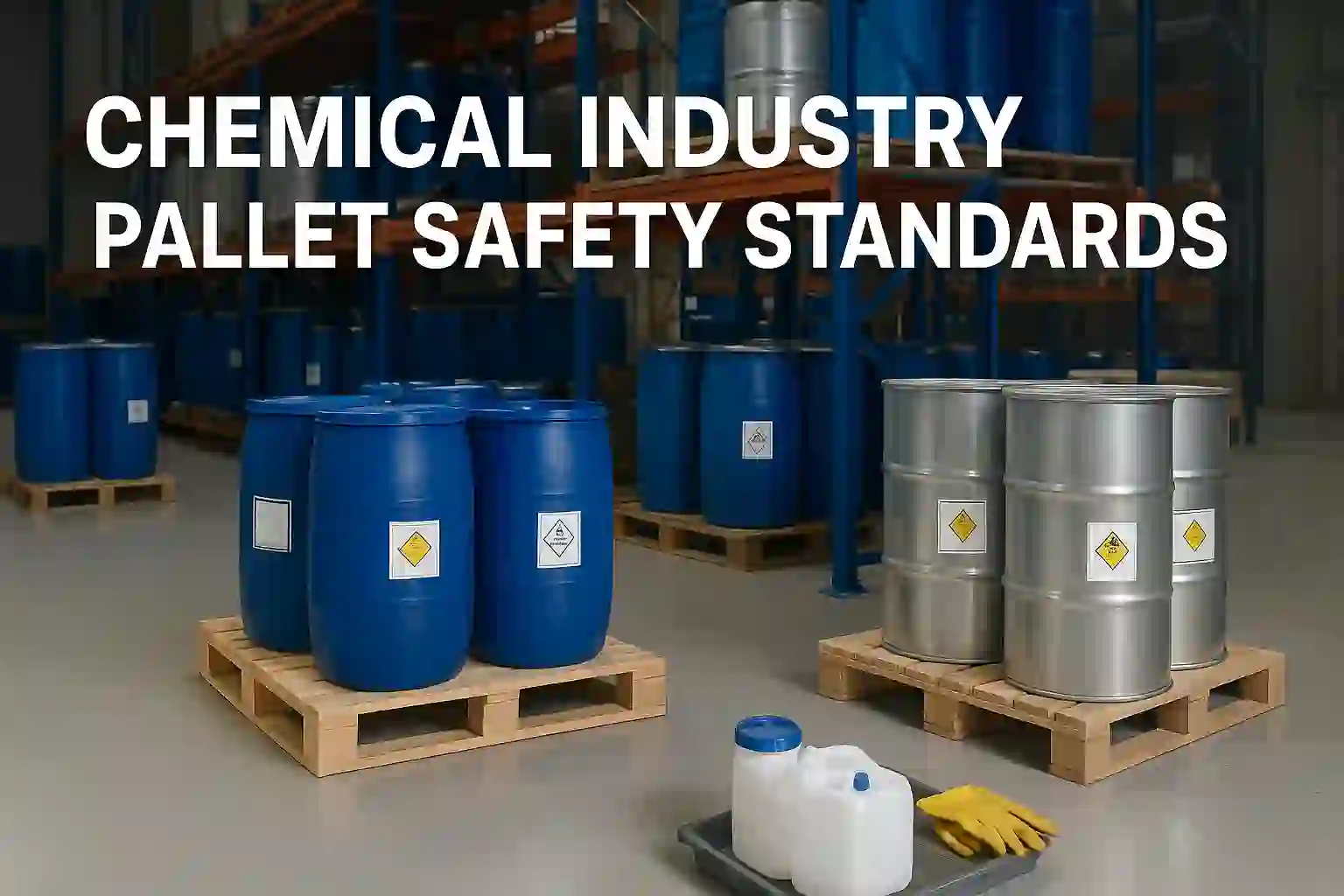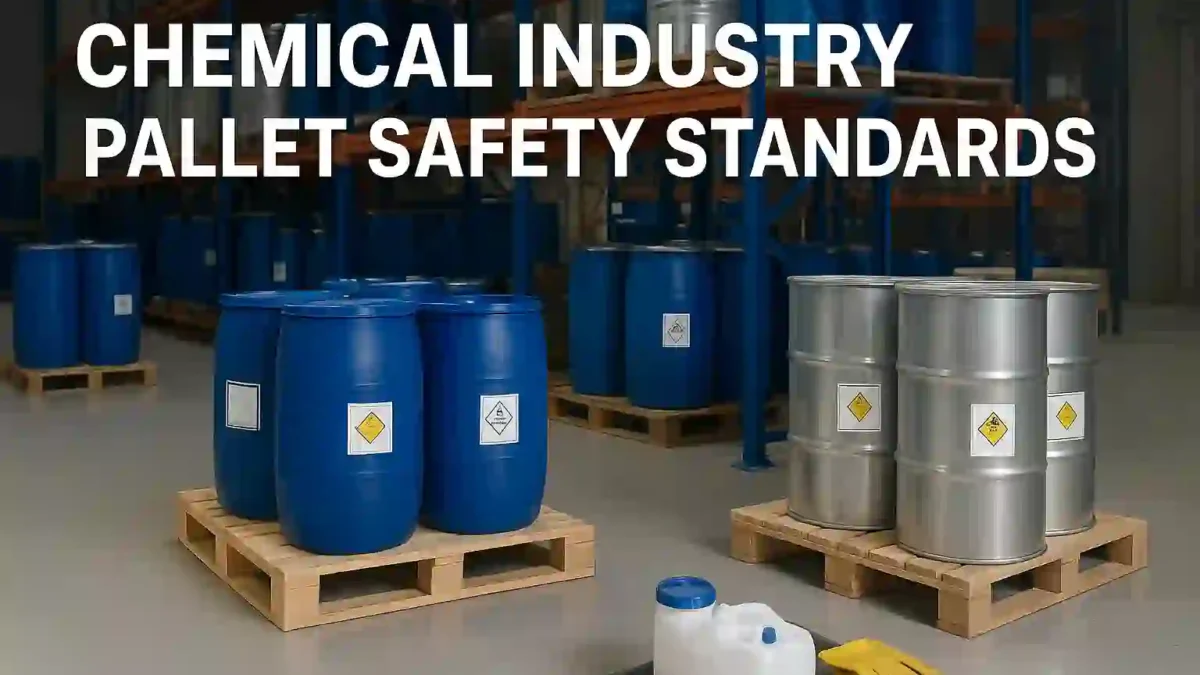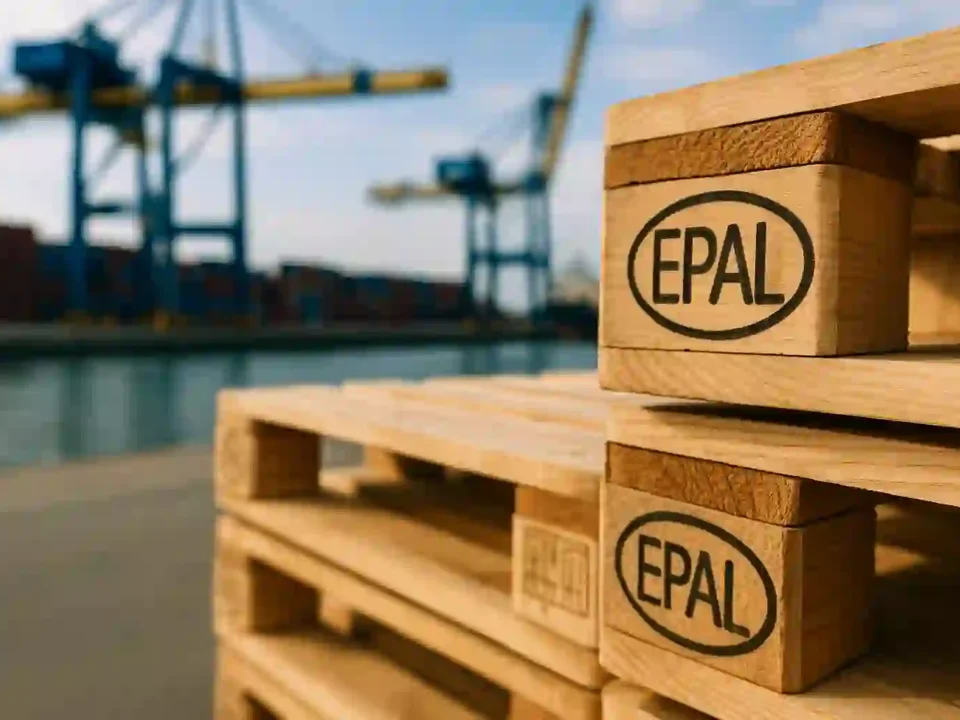Choosing the right pallet depends on storage needs, chemical compatibility, and durability. Plastic prevents contamination, wood suits lighter applications, and metal ensures strength for high-density chemical handling and repeated use.

CP9 Pallet Specification Guide: Dimensions, Standards, and Benefits
September 10, 2025
Pallets for Food and Beverage Logistics: Choosing the Right Type
October 16, 2025Chemical Industry Pallet Safety Standards
Chemical industry pallet safety standards define how materials move, store, and stay secure inside a facility. The right pallets prevent leaks, protect workers, and keep hazardous products under strict control.

According to the Verband der Chemischen Industrie (VCI) guidelines, safety begins with the pallet. Their detailed framework explains how design, durability, and compliance combine to reduce chemical handling risks.
Why Safe Pallets Matter in the Chemical Industry
Safe pallets keep hazardous materials stable, prevent leaks, and protect workers. They form the base of every storage and transport system—one weak pallet can trigger major safety issues.
Risks of Poor Pallet Selection
Using the wrong pallet invites contamination, breakage, and product loss. In chemical storage, even small cracks or moisture can lead to spills, fines, or complete batch rejection
Impact on Safety, Cost, and Compliance
Reliable pallets cut down accidents, reduce cleanup costs, and simplify audits. Choosing certified materials also keeps operations aligned with industry and environmental standards, saving time and reputation alike.
Industrial Pallets for Chemicals, Key Material Choices
Industrial pallets for chemicals come in wood, plastic, and metal. Each material offers unique benefits: plastic resists chemicals and is hygienic, wood is cost-effective, and metal handles heavier loads reliably.
ISPM 15 Pallets for Chemicals, Global Compliance Basics
ISPM 15 sets international rules for wood packaging, requiring heat treatment or fumigation to prevent pests. Pallets must be clearly marked, ensuring safe global transport of chemicals.
India enforces these standards through plant quarantine and customs regulations. Imported pallets without proper ISPM 15 certification may be treated, returned, or destroyed to comply with legal and safety requirements.
Safe Pallets for Chemical Storage, Design and Handling Rules
Safe chemical storage starts with pallets designed for load limits, proper ventilation, and controlled stacking heights. Correct labeling and spill containment measures prevent accidents and maintain organized storage.
Handling best practices include using forklifts carefully, inspecting pallets regularly, and separating incompatible chemicals. Clear markings, color codes, and routine maintenance ensure compliance and minimize risk of leaks or damage.
Chemical Warehouse Pallet Requirements
Chemical warehouses require pallets that meet strict safety and operational standards. Proper material selection, stacking, and organization reduce risk, ensure smooth workflow, and maintain regulatory compliance.
Fire Safety and Material Segregation
Pallets must support fire safety by keeping flammable chemicals separate and allowing clear access for firefighting equipment. Segregation prevents dangerous reactions between incompatible substances.
Cleanliness, Maintenance, and Inspection Routines
Regular cleaning, inspection, and maintenance of pallets prevent contamination, damage, and wear. Scheduled checks ensure that pallets remain safe, hygienic, and suitable for chemical storage operations.
Pallet Regulations for Hazardous Materials
In India, handling hazardous materials is governed by MSIHC Rules, CPCB guidelines, and PESO regulations. These frameworks cover storage, labeling, transport, and emergency preparedness.
For international facilities, UN packaging standards and OSHA rules ensure chemical safety, proper stacking, and risk management. Compliance minimizes accidents, protects workers, and meets legal requirements globally.
Wood vs Plastic Pallets in the Chemical Industry
Wood pallets are cost-effective and sturdy but prone to contamination and limited chemical resistance. Plastic pallets resist chemicals, are hygienic, reusable, and easier to clean.
Plastic pallets also support sustainability, with many being recyclable and reducing waste. Wood can be recycled or repurposed, but may have higher disposal and maintenance requirements over time.
Pallet Compliance in the Chemical Industry: What You Need to Track
Compliance requires accurate documentation, proper labeling, and thorough audit trails. Regular inspection reports help track pallet condition, while employee training and periodic verification maintain consistent safety standards.
Chemical Handling Pallet Guidelines, Best Practices for Everyday Operations
Safe chemical handling relies on proper loading techniques, secure transport, and effective spill containment. Using forklifts correctly, following stacking limits, and labeling pallets clearly reduces accidents and protects workers.
Chemical Storage Pallet Standards – Final Thoughts
Chemical storage pallet standards are essential for safety, compliance, and efficiency in every facility. Choosing the right pallets reduces accidents, protects workers, and ensures smooth operations.
Investing in high-quality pallets pays off long-term. Check out our wooden pallet page and contact us to discuss the best solutions for your chemical storage needs.




